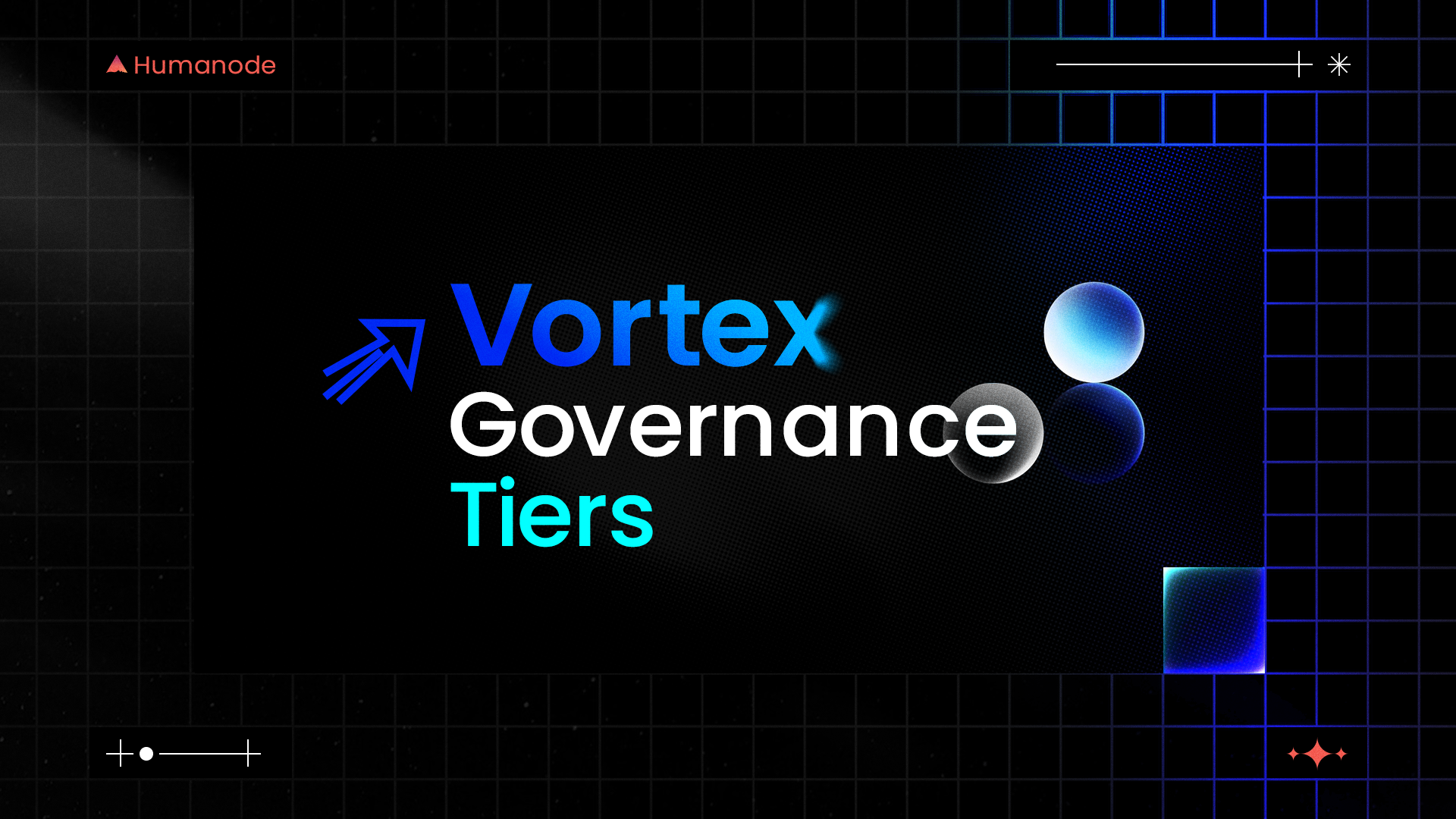The Vortex Blueprint: Governance Tiers Explained

As Humanode advances its research and development of Vortex, the core of the Humanode DAO, it is time to revisit the governance structure in Humanode, little by little.
As one person = one node = one vote, Humanode aims to become the first fully and truly democratic DAO on blockchain.
This means that the vote of a founder or core team member of Humanode carries equal weight to that of any other human node participating in governance.
This also means that a proper structure is required to make sure that Humanode does not fall into total chaos.
Humanode is built with the people (biometric identities), for the people (users), by the people (community members and governors). This is not some random meme coin or trash project that wants to enrich the few who already probably have too much power and money.
Thus, we need people to participate to make things happen, and we need as many human nodes as possible to participate in governance. The more that participate, the safer the network.
But the Humanode Core runs the project, you say.
Yes, the project was started with a handful of people. Yes, the core of the project, who are dedicating their lives to the project, still hold power over the direction of development and wield the “rules of the project”.
But soon, this will start to change. Once the key cornerstones of this project are in place, the community of human nodes, especially those who participate in the building of the project and earn Proof of Time and Proof of Devotion, will start to rise in power and eventually become the ones that hold the reins.
Although many already understand the proposed structure, today, we would like to use this opportunity to go over the core characteristics and tiers of governance.
Core Characteristics of Vortex
Just as a refresher, let us first quickly go over the core characteristics of Vortex.
- Equal Voting Power: All human nodes have one vote, regardless of wealth or stake.
- Tiered Participation: Participants gain access to different proposing rights based on their activity and commitment over time. Higher tiers, such as Citizens, can propose structural changes to the DAO. It is important to remember that tiers do not increase the power of one’s voice.
- Cognitocratic - meritocratic Evolution: Governance power is determined by non-financial credentials - length of activity, uptime, proposal participation, and constructive contributions to the network.
- Chamber System: The Vortex DAO is composed of multiple governance chambers, each representing a specialization or focus area. Chambers can create and review proposals, assign formation grants, and coordinate policy development.
- Proposal Pooling: New ideas and upgrades enter through a proposal pool system, where attention and preliminary support determine progression toward formal voting.
- Dynamic Metrics: A participant's influence is tracked via Cognitocratic Measure (CM) Scores and proposal reputation, dynamically adjusted based on historical behavior and chamber assessment.
Importantly, Vortex also enables constitutional overrides, like chamber dissolution and vote of censure, ensuring that governance structures remain transparent, flexible, and responsive to abuse or inaction.
The Tiers
Ok, now that we have gone over the major key points, let's get into who can govern, and what the tiers of Governors are.
So, who can partake in Humanode governance? You can. Any validator, or human node, on the Humanode Chain has the opportunity to participate in governance. No need for “Governance Tokens”. The whole process should take you less than 2 USD (to get Bio-authenticated and start your node) if you run your node from home, and 10 USD or less per month if you run your node on a cloud server. (Just remember that if you validate for the full 168 epochs per month and participate in simple activities, you can earn 25 USD per month, so you wouldn’t be at a loss.)
Because it is easy to become a validator on Humanode, and thus just as easy to get involved in governance, it may seem as if someone could try to jump in, rally all of the degens in some mining pool group, propose that Humanode get rid of Sybil-resistance, allow bots, and give all validators $10000 each until the treasury runs dry. After all, every vote holds equal weight, so who gives a damn about what the founders intended… right?
Well, that won't be so easy. Why? Well, the answer is simple. Although the weight that all votes carry is equal, the power of proposal that a governor holds depends on the tier of the governor. The tiers are decided based on Proof of Time (PoT), Proof of Devotion (PoD), and Proof of Governance (PoG), and as mentioned above, the higher the tier, the more proposal power.
The first step in governance is to become a “Nominee”. Think of this as you showing your willingness to participate in governance, and gaining your “training wheels”.
Tier 1 Nominee:
A nominee is a Human node who sets out to receive voting rights in any of the chambers. Although a nominee cannot partake in voting, he is already able to participate in any projects that are assembled in Formation and make proposals to chambers, excluding those connected to Fee distribution, Monetary System, Core Infrastructure, Administrative, DAO core.
This is where Proof of Devotion kicks in.
Tier 2 Ecclesiast:
The second tier is achievable only when a proposal submitted by the nominee gets accepted by the governors in a chamber. From this point on, a governor can start actively participating in governance according to the governing requirements and are also allowed to make Fee distribution and Monetary System proposals.
All three proofs become a major key factor from here on.
Tier 3 Legate:
The third tier requires a demonstration of prolonged governing participation and passage of the meritocratic barrier by direct participation in the processes of the Humanode ecosystem. In short, one would need to run a node for one year, be an active governor for one year, have their proposal accepted in Vortex, and have participated in a project through Formation. Once a governor becomes a Legate, the governor may also propose changes to the core infrastructure.
Tier 4 Consul:
The fourth tier unlocks the ability to make administrative proposals, such as types of human nodes, their rights, and requirements, or the rights, requirements, and obligations of the governor tiers. Naturally, the requirements become higher, and they are required to have run a node for a minimum of 2 years, be an active governor for 2 years, have their proposal accepted in Vortex, and participate in a project through Formation.
Then comes the final Tier.
Tier 5 Citizen:
The fifth and final tier unlocks the ability to propose changes to the DAO core. The requirements are to have run a node for 4 years, be a governor for 4 years, be an active governor for at least 3 years, have your proposal accepted in Vortex, and participate in a project through Formation.
As the various Chambers start to emerge, each Chamber may have various requirements. It may seem as if some chambers may be easier to earn a seat in governance than others. But it is important to remember that you would need to have real knowledge and experience in the field for the Chamber that you would join. So, a designer may not do as well in the Chamber for core developers, nor would a well-known UI/UX designer necessarily become a superstar in the Chamber for Media or Business Development.
Yes, we are at least 6 months away from having the bare-bones infrastructure in place, so it may seem a long way away… but time flies by quickly, and what you do today also counts towards the future. Get involved. Start building. Assist with business development or marketing. Make concrete proposals that you can assist in, especially if you believe it will launch Humanode to the moon. Don’t be an invisible face that just farms $25 a month. Join the community, and become a pillar of the community.
If you are interested in learning more about Vortex or the philosophy behind the whole concept, we highly recommend you read the following papers.
Vortex 1.0: https://gitbook.humanode.io/vortex-1.0
Humanode Whitepaper: https://whitepaper.humanode.io/

